Atlantic Monthly Contributors's Blog, page 99
August 15, 2016
Guantanamo's Shrinking Population
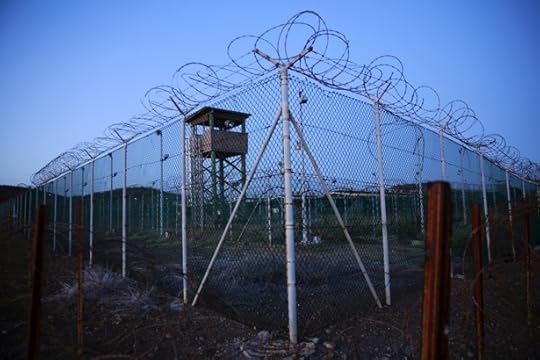
NEWS BRIEF The United States has released 15 prisoners from the Guantanamo Bay prison and sent them to the United Arab Emirates, marking the largest single transfer of detainees in the Obama presidency.
The prisoners, 12 Yemenis and three Afghans, were deemed to no longer pose a security threat to the country by the special task force created in 2009 to review Guantanamo inmates’ cases, the Pentagon said in a statement Monday.
The transfer brings the total number of detainees at Guantanamo to 61, the Pentagon said. Most have been there for more than a decade.
“The United States coordinated with the Government of the United Arab Emirates to ensure these transfers took place consistent with appropriate security and humane treatment measures,” the Pentagon said.
The detainees are:
Abd al-Muhsin Abd al-Rab Salih al-Busi, Abd al-Rahman Sulayman, Mohammed Nasir Yahi Khussrof Kazaz, Abdul Muhammad Ahmad Nassar al-Muhajari, Muhammad Ahmad Said al-Adahi, Abdel Qadir al-Mudafari, Mahmud Abd Al Aziz al-Mujahid, Saeed Ahmed Mohammed Abdullah Sarem Jarabh, Mohammed Kamin, Zahar Omar Hamis bin Hamdoun, Hamid al-Razak (aka Haji Hamidullah), Majid Mahmud Abdu Ahmed, Ayub Murshid Ali Salih, Obaidullah, and Bashir Nasir Ali al-Marwalah
The United Arab Emirates has accepted more than 20 inmates, according to a comprehensive database maintained by The New York Times. Afghanistan has accepted the most, at 203 inmates.
The push to empty Guantanamo began in 2006, under the Bush administration. President Obama has sought for years to make good on a campaign promise to shut down the camp and wants to transfer the final detainees to maximum-security facilities on U.S. soil, but has been blocked by Congress.
About 780 inmates have been held at Guantanamo since it opened in 2002, built after 9/11 to house dangerous terrorism suspects.

The College Dorm and the Confederacy
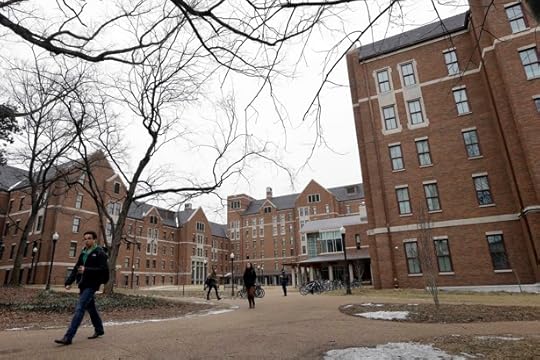
NEWS BRIEF A Tennessee college will remove a controversial inscription from one of its dormitories, returning an 83-year-old donation for the construction of the building.
The chancellor of Vanderbilt University, Nicholas Zeppos, announced Monday the school would remove “Confederate Memorial Hall,” the name engraved in the stone above the main entrance of a residence hall. Zeppos called the inscription a “symbol of exclusion” in a statement to the university, a private undergraduate and graduate college in Nashville.
“It spoke to a past of racial segregation, slavery, and the terrible conflict over the unrealized high ideals of our nation and our university, and looms over a present that continues to struggle to end the tragic effects of racial segregation and strife,” Zeppos said.
The dorm will be renamed Memorial Hall, the name that has been used in all campus housing assignments, websites, maps and other materials for more than a decade, according to the school.
Vanderbilt will return $1.2 million to the Tennessee chapter of the United Daughters of the Confederacy, the present value of the $50,000 the group donated to the school in 1933 for the construction of the dorm. The United Daughters of the Confederacy is a national organization of female descendants of Confederate soldiers who fought in the Civil War. Back then, the dorm was part of the George Peabody College for Teachers, an independent institution that merged with Vanderbilt in 1979, according to the school. The inscription has been in place since the dorm’s construction in 1935.
The payment complies with a 2005 court ruling in the state. In 2002, Vanderbilt tried to rename the building and drop the inscription, but the Tennessee branch United Daughters of the Confederacy sued the school, arguing it was breaching a contract. A Tennessee appeals court ruled the school could only remove the inscription if it returned the 1933 donation to the group at its value in current dollars. But “Vanderbilt chose to use those funds ... for other purposes rather than enrich an organization whose values it does not share,” the school said.
The $1.2 million payment will come from anonymous donors who gave specifically for the removal of the inscription, the school said.
Various institutions, public and private, in the United States have reconsidered and removed Confederate references and imagery in the last year, most in response to the mass shooting of members of a historically black church in Charleston in June 2015, perpetrated by a gunman who had posed with the battle flag in pictures before the rampage. The Confederate flag was removed from South Carolina’s statehouse a month after the shooting, and lawmakers in some southern cities voted to take down Confederate memorials within their borders. Last August, the University of Texas removed a bronze statue of Jefferson Davis, the Confederate president, that had stood on campus since 1933.

The Bombing of a Hospital in Yemen
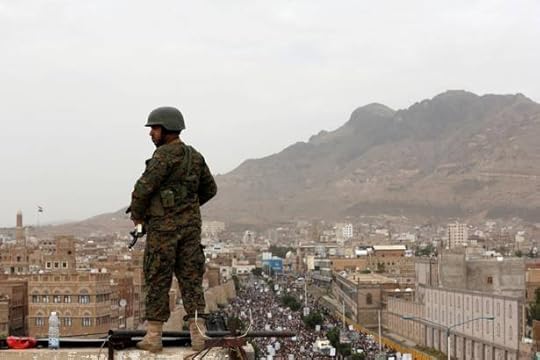
Updated on August 15 at 5:24 p.m. EST
NEWS BRIEF An air strike struck a hospital in northern Yemen on Monday, killing 11 and wounding at least 19, Médecins Sans Frontières (Doctors Without Borders) said in a statement.
The strike, which news outlets say was conducted by Saudi-led coalition forces, partially destroyed Abs Hospital, a facility in Hajja province, which MSF has run since July 2015. More than 4,000 patients have been treated in the facility over the past year.
“This is the fourth attack against an MSF facility in less than 12 months,” said Teresa Sancristóval, the MSF emergency program manager for Yemen. “Once again, today we witness the tragic consequences of the bombing of a hospital. Once again, a fully functional hospital full of patients and MSF national and international staff members was bombed in a war that has shown no respect for medical facilities or patients.”
A day before the strike, MSF tweeted saying access to health care is increasingly limited in the country, where the humanitarian situation has deteriorated since hostilities between the Saudi-led coalition and Houthi rebels resumed last week following the collapse of United Nations-facilitated peace talks.
Access to humanitarian supplies was further complicated last week with the closure of Yemen’s airspace by the Saudi-led coalition, which has barred humanitarian and commercial flights from entering the Sanaa airport, according to Oxfam International.
MSF-run medical facilities have been the repeated targets of air strikes in Syria, Somalia, and Afghanistan in the last three years, leading to the deaths of dozens of patients, doctors, and staff. The Nobel Peace Prize-winning humanitarian group experienced one of its worst attacks in October when a MSF trauma facility was hit by a U.S. air strike in Kunduz, Afghanistan, killing 42 people.
The attack on the hospital in Yemen comes after an air strike hit a school in northern Yemen Saturday, killing 10 children and injuring 21 others. The bombing coincided with the convening of Yemen’s parliament for the first time in two years—a move seen as bolstering the Iran-allied Houthi rebels, who have controlled the capital of Sanaa since 2014. The government, backed by the Saudi-led coalition, called the parliamentary session illegal.
The UN-led peace talks collapsed last week after the Houthis and the party of former President Ali Abdullah Saleh created a 10-member governing council to run the country—a move condemned by the government and the UN as a constitutional violation. The talks first began in Switzerland in December, nine months after the conflict began. They resumed in Kuwait after both sides reached a temporary ceasefire in April.
The Saudi-led coalition began a campaign of air strikes against Houthi-controlled areas in Yemen in March 2015. Since then, the UN estimates that more than 9,000 people have been killed, mostly civilians. More than two million people have been internally displaced.

Donald Trump's Intolerance for Intolerance
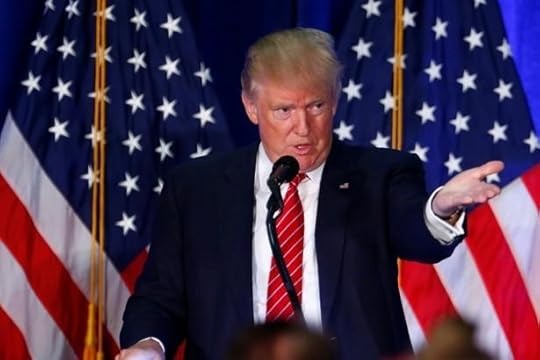
In Mario Cuomo’s famous phrase, leaders campaign in poetry and govern in prose. But as Donald Trump is finding, sometimes the gap is larger still—more like translating across languages.
Take one of Trump’s central policy planks since last fall: excluding people who might pose a risk of terrorism from entering the United States. The Republican nominee has run through a range of different versions of the policy, working to transform an idea that resonated strongly with his voters during the Republican primary into a workable proposal—so far, with minimal success. His latest swing, proposing an unusual ideological test, is part of a foreign-policy speech Trump delivered in Youngstown, Ohio, on Monday.
Trump first announced he wanted to ban Muslims from entering the United States in the wake of the San Bernardino shooting. Initially, it appeared that the proposal could encompass barring even American citizens who are Muslim and traveling abroad from reentering the country. The campaign eventually scaled that back to involve apparently only non-citizens and non-permanent residents. That proposal was widely decried as unworkable—it would overwhelm the immigration system, officials said, and besides, couldn’t respondents simply lie about their religion?—and likely unconstitutional because of its religious test; in any case, it seemed to violate American principles.
In a later iteration, therefore, Trump said he would ban immigration from countries with a track record of terrorism. Trump more or less admitted this was a sham: “People were so upset when I used the word ‘Muslim.’ ‘Oh, you can’t use the word “Muslim.”’ Remember this. And I’m OK with that, because I’m talking territory instead of Muslim.” The switch circumvented the religious test, but raised other problems. For example, would it prevent immigration of people from Britain, France, or Belgium, countries that have grappled with a series of terrorist attacks? Trump was vague. At one point, he said that Muslims from Britain would be acceptable.
Meanwhile, the territory-based idea created other problems. The plight of Christians in the Middle East, who have been persecuted by ISIS, al-Qaeda-linked groups, and others, is a popular cause with Christians in the United States, particularly the conservative ones who form an important part of the Republican base. The plight of Jews in Muslim countries is also a treasured cause. That created a bind for Trump’s running mate Mike Pence, as my colleague Emma Green reported. Pence needed to defend Trump’s policy without appearing to be abandoning persecuted Christians. A Pence spokesman later said that he would support the creation of “safe havens” where Christians and Jews could be protected while being vetted.
The idea of safe havens for refugees is not new, but it has proven tricky to implement. It is either extremely costly and logistically challenging, or else it tends toward failure and tragedy, as occurred with inadequately protected UN “safe areas” in Bosnia during the 1990s.
Trump’s latest idea is to focus on individuals themselves. The AP reports that those seeking to enter the U.S. would be queried on their stances on issues like religious freedom, gender equality and gay rights: “Through questionnaires, searching social media, interviewing friends and family or other means, applicants would be vetted to see whether they support American values like tolerance and pluralism.”
He was somewhat more vague in the speech itself:
In the Cold War, we had an ideological screening test. The time is overdue to develop a new screening test for the threats we face today.
In addition to screening out all members or sympathizers of terrorist groups, we must also screen out any who have hostile attitudes towards our country or its principles—or who believe that Sharia law should supplant American law.
Those who do not believe in our Constitution, or who support bigotry and hatred, will not be admitted for immigration into the country. Only those who we expect to flourish in our country—and to embrace a tolerant American society—should be issued visas.
It’s an interesting approach, not least in the items Trump’s advisers have named as criteria. Trump has struggled to support religious freedom, not least with his initial Muslim immigration proposal. He has struggled with tolerance more broadly, for example offering a highly dubious definition of free speech and calling for stricter libel laws. Trump might be in the position of demanding that those seeking to immigrate to or seek refuge in the United States uphold values that he himself seems ambivalent about.
The focus on tolerance points to one of the great paradoxes of immigration in liberal democracies. By insisting that immigrants follow certain, particular values, Trump is aligned with the anti-immigrant right in Europe, a constellation of populist political parties that have lobbied against “multicultural” conceptions of society. Their supporters argue that there is a tension between values: On the one hand, societies in Western Europe and the U.S. have tended to view welcoming beleaguered immigrants in as a moral imperative. But what happens if Enlightenment values of tolerance and democracy produce an influx of people who are not committed to those values, and who irreversibly change the body politic to eventually undermine them? For these groups, and for Trump, certain measures of intolerance are vital for ensuring tolerance. Their opponents contend that to say so is to step down a slippery slope.
Ideological tests for admission to the country are not new. As far back as the Alien and Sedition Acts in John Adams’s presidency, U.S. policymakers have sought to restrict who can and cannot enter the country, remain in the country, or become a citizen. In 1903, Congress banned anarchists from entering the United States after a worldwide outbreak of anarchist violence. Currently, anyone wishing to become a citizen or a permanent resident is asked whether he or she is or has ever been a member of the Communist Party, a totalitarian party, the Nazi Party, or a terrorist organization. Applicants for asylum are asked whether they have been members of political parties, guerrilla groups, or paramilitary organizations.
These questions are somewhat straightforward: They exclude people based on whether they are members of groups that seek the overthrow of the U.S. government and political system. Trump’s suggestion is murkier, and goes beyond a simple exclusionary test. For example, plenty of Americans oppose gay rights and even gender equality, and while it isn’t hard to find progressives willing to label those views “un-American,” they are also constitutionally protected views for citizens and residents, and within mainstream discourse.
An ideological test such as this presents two major risks of manipulation, one each by the asker and the answerer. From the government side, an ideological test can quickly be turned to questionable purposes, and interpretations can vary widely. For example, many Republican regard the argument that women are underpaid for the same work as men as a canard. Would agreeing with them get a prospective immigrant blacklisted? From the other side, wouldn’t it be relatively simple for an applicant to simply lie?
What unites all these caveats is a question of the extent to which Trump truly understands the current system for refugee intake. In Maine earlier this month, he warned that refugees to the United States are coming from the “most dangerous places,” an almost comical point: The very essence of a refugee is that she is coming from a place of danger. Refugees by definition do not come from stable, tolerant, liberal democracies.
Trump has also claimed, falsely or at the very least with great hyperbole, that there is “no system to vet” refugees from the Middle East. At other moments, he has simply said the system is bad: “There’s no way to properly vet these people, so what they do is make up paperwork.” There is a system in place, and it is exceedingly rare for refugees (and those who have been granted asylum in the U.S.) to commit acts of terrorism. The State Department told Fox News that about 12 out of 785,000 refugees admitted to the U.S. since 1975 have been deported or arrested thanks to security concerns that existed before they entered the U.S. Another minuscule fraction has become involved in terror later. But doubters say that it only takes one or two successful terrorists to produce carnage, and some critics, including my colleague David Frum, have deemed the system fraught.
What would Trump do to rectify the problem? His system of questionnaires, interviews, and background checks sounds broadly similar to the current system, which involved interviewing applicants, combing for worrisome connections, and checking their names against intelligence files. The inclusion of social media is somewhat fresher. The revelation, following the San Bernardino attacks, that U.S. screeners were not searching for applicants on social networks infuriated many conservatives. But that, too, has already changed, with the Department of Homeland Security scrambling to include those networks in their process.
Taken in sum, Trump’s ideas seem to have evolved from a clear-cut but arguably illegal process in the first place to a proposal that now largely resembles the status quo, although with a few additional, vague tests. What Trump calls “extreme vetting” looks quite a bit like the existing vetting, only with an adjective attached. If the past is any indication, however, Monday’s proposal may prove to be just another rough draft as well. Translation is an inexact and imperfect art.

The Olympic Guide to Ladybragging

Simone Biles, when she hasn’t been winning gold medals (three so far) and crushing expectations, has been tweeting. Things like this:
wow I did it - Olympic Vault Champion
The Reality of Those 'Real People, Not Actors' Ads
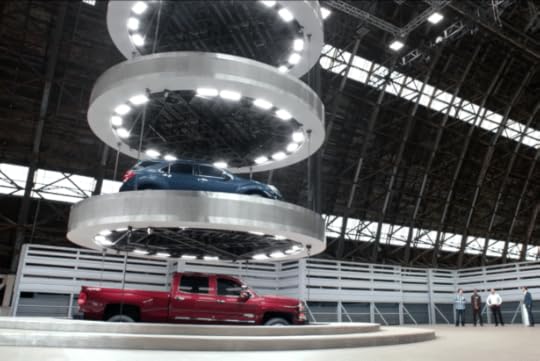
During commercial breaks at the Olympics viewing parties I’ve been at in the past week, one company’s ads have consistently sent the room into a round of existential questions. What is reality? Aren’t we all actors? Just how excited can a normal person get about J.D. Power awards?
In Chevrolet’s “Real People, Not Actors” ads, focus-groups participants react enthusiastically to information about automobiles. Sometimes, this is accomplished with a high-concept trick, like when the moderator pretended to destroy the group’s cell phones to show the importance of having a ride with wi-fi. At other times the pitch is more straightforward, like with the spots running frequently during the Olympics that emphasize the accolades Chevrolet has earned. “Thanks for blowing our minds,” one participant says, and it’s not clear whether she’s referring to Chevy’s award-winning dependability or the enormous elevator that’s been hoisting cars into the air in front of her.
The campaign, airing for nearly two years now, is the latest incarnation of the regular-folks-as-spokespeople trope that led to such advertising landmarks as the Pepsi Challenge and Dove’s “Real Beautiful” commercials. “Of late, still more brands are turning to Average Joe instead of Angelina Jolie to hawk their products,” wrote Lucia Moss in a 2012 AdWeek piece positing that ad agencies were increasingly casting real people to avoid situations like the one that unfolded when scandal marred the reputation of the famous product endorser (and golfer) Tiger Woods.
There are other reasons why ads like these may be flourishing: They follow reality television in showing a highly edited version of real life, they confirm the centrality of market research in corporate boardrooms, and they mimic social media’s way of shaping how people make choices.
“The number-one way people today find out about things is they look for people they trust,” Steve Majoros, Chevrolet’s director of marketing, told me. “If you needed help to replace your furnace or air conditioner or roof, what’s the first thing you’re going to do? You’re going to do a Facebook shoutout … We want to make people feel like, hey, this isn’t just us telling you. This is your friends, your neighbors, your coworkers, people just like you.”
But the strategy does run the risk of irritating viewers. Adweek has praised the Chevy campaign as “really well done,” but it’s not hard to find complaints elsewhere online about the commercials and the larger trend they represent (sample Jalopnik headline: “‘Real People’ In Car Ads Make Me Hate Myself And Everybody Else”). Using ordinary folks to counter viewer skepticism towards advertising, it seems, can trigger even greater skepticism. Last year, a writer for The News Wheel noticed that some of Chevy’s focus-group members had, in fact, worked as actors before; a GM representative said that this was an unintentional result of recruiting in Los Angeles—you’re going to end up with a few people who have IMDB pages.
Majoros insists that the “real people” really are real (save the moderator, actor Potsch Boyd). While the company obviously edits footage to “tell the best story,” the participants don’t know what brand they’re interacting with when they show up, and the reactions on screen are genuine. Chevy’s recruiters do try and find folks who are “emotive” and “expressive,” as well as within the target demographic of the ad. “When you have stimuli that is inextricably linked to the product message, it elicits feedback that we don’t need to script or stage,” Majoros said.
The large car elevator in the company’s recent spots is one example of such “stimuli.” Majoros said that commercial was filmed in a hangar in Tustin, California, where they used a stage to obscure the cars queued up below participants’ feet, ready to be brought aloft. “Chevrolet has a series of brand values, and one of the brand values is authenticity,” he said. “So what you don’t see from Chevrolet is a lot of CGI wizbangery. We are about real things. But it has to be dramatic!”
When I gently brought up the notion that some people seem to find the ads smarmy, exactly the opposite of what an ad campaign based on real peoples’ opinions might be aiming for, Majoros pointed out that Chevy’s audiences’ testing has demonstrated measurable, positive effects from the ads. It’s fitting: Commercials about market research are going to also be the product of market research. “On the bell curve you have your haters and your lovers,” Majoros said. “It’s like gymnastic scoring. Throw out the high, throw out the low, and see how the masses are reacting.”

What's Happening in Pakistan's 'Most Complicated' Region?
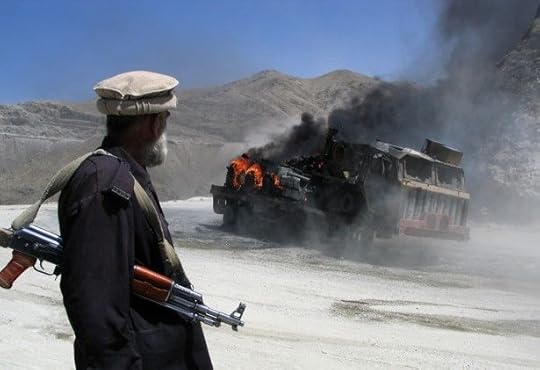
A suicide bomber in Pakistan killed 70 people last week, many of them lawyers, who had come to a hospital to mourn the death of a colleague. ISIS and a local Taliban faction both claimed credit for the attack in Quetta, the capital of Balochistan province, the scene of a longtime separatist rebellion.
The roots of conflict in the province date back to 1947, when British India gave way to two countries, Pakistan and India. For decades the separatist movements have been crushed by the Pakistani military, which blames India for fomenting the unrest. In one five-year period in the 1970s, more than 8,000 people were killed in a fight to separate from Pakistan . Today, bodies turn up on the side of roads, mysterious mass graves are uncovered, security forces kill Baloch leaders, and human-rights groups say nearly 10,000 people have vanished in the past decade.
There is little journalism in the area, because, as one Pakistani paper put it, not being dead is itself a victory for reporters. Balochistan’s lawyers filled this void, campaigning for human rights amid the fight between the military and separatist rebels. This is why the loss of so many attorneys this week is so devastating. Barkhurdar Khan, a local lawyer in Quetta, said nearly every colleague who had mentored him, or even anyone who had given him a lift home after work, was now dead. The bombing killed an entire generation of legal minds.
To understand the gravity of such loss, and what it means for the region, I spoke with Hussain Haqqani, a former ambassador of Pakistan to the United States, and a senior fellow at the Hudson Institute. What follows is some of our conversation, edited and condensed for clarity.
J. Weston Phippen: Can you tell me a little about the history of violence with militant extremists, the military, and the separatists in the region?
Hussain Haqqani: The Baloch have been mounting an insurgency against the Pakistani state for several decades. It has always been a low-level insurgency, and Pakistan has occasionally accused Afghanistan and India of supporting the Baloch, although it has not been able to prove that allegation.
Balochistan was also the staging ground for the war against the Soviets during the 1980s. But it became even more important during the rise of the Taliban, and for many years the U.S. government and the international community have accused Pakistan of providing safe haven to the Taliban in Bolochistan. There have been suggestions that the Pakistani intelligence service uses the area—especially in Quetta—for activities it wants hidden form the view of the international community.
Phippen: How would you explain the political situation today?
Haqqani: Significant parts of Balochistan are not necessarily controlled by Pakistan’s central government. The ethnic Baloch areas have a greater sympathy for nationalists who would like to see either an independent or autonomous Balochistan. The army tries to suppress them, sometimes with the help of religious extremists.
Also, the elected government in the province did not get significant mandates because the Baloch parties boycotted the last election and many people were elected with the low turnout of 10, 12, in some places 15 percent. So these political leaders are seen by the majority of Baloch as the puppets of Islamabad.
Phippen: Why do they want to separate from Pakistan?
Haqqani: This goes back to the country’s creation, when the Muslim majority part of India left and became Pakistan. Some Baloch leaders say Balochistan’s integration into Pakistan was done forcefully. But more important than that is the neglect. This is a resource-rich province, and instead of the people benefitting from those resources, they end up in other parts of Pakistan.
Phippen: Lawyers have played an important role in criticizing the corruption in the area, which there is a lot of. … Can you tell me how lawyers play a role in seeking justice?
Haqqani: Yes, lawyers have spoken out against corruption, but more importantly, they have criticized the Pakistani army and its conduct. In Balochistan, you must remember, the Pakistani army has been accused of killing and dumping the bodies of Baloch nationalists. It has been accused of having hundreds of people abducted without trial. With all those allegations around, the role of those lawyers becomes important because they are the voice against such excess.
Phippen: So how do terrorists factor into this?
Haqqani: The jihadi groups in the border are competing for recruitment. Most of them are local groups, and each one is trying to prove they are stronger in their advocacy of Islamic rule than the other. Some have engaged in attacks in Quetta as a means of trying to build credibility as the principal insurgent group, and I think the attacks on lawyers are part of this trajectory. … The lawyers represent a more secular, modern outlook. That does not sit well with the jihadi’s Sharia-based approach to law.
Phippen: What does this loss mean in terms of legal knowledge and skill?
Haqqani: Balochistan is sparsely populated, and the ethnic Baloch are a relatively small minority. They are no more than 5 million in a country of 200 million. They have a very small number of lawyers, so any loss is big in terms of not being able to represent the people of this ethnic group.
So for example, say there are a small number of black lawyers in a southern town in the U.S. and all of them are eliminated. The black community no longer has lawyers to represent it. Something similar has now happened in Balochistan.
Phippen: Both ISIS and a local group affiliated with the Taliban claimed responsibility for the attack, what do you make of that? Are they just trying get the notoriety, or is there collusion?
Haqqani: It could be both. A lot of jihadi groups work together, and in some cases their membership overlaps. ISIS in Afghanistan and Iraq is still taking shape.
Phippen: What can Pakistan do to prevent these attacks in the region?
Haqqani: The Pakistani military has to have a clear definition of who it considers the enemy. Instead of cultivating one group of jihadi and fighting others, it needs to go after all jihadi and extremist groups. It also needs to start a process of reconciliation with the Baloch nationalists. These are citizens of Pakistan who feel they have been neglected, and therefore are feeling restive and unhappy. Putting in more troops is only going to escalate the violence. Not end it.
Phippen: Well, thank you for your time.
Haqqani: Let me add one thing.
Balochistan is Pakistan’s most complicated region, and unfortunately people try to simplify the problems there. It is not all about the mistakes of the Pakistani military, or the corruption of civilians in power, or the nationalists, or the presence of the Taliban. It is all those things.

A Carnegie Legacy in Dodge City
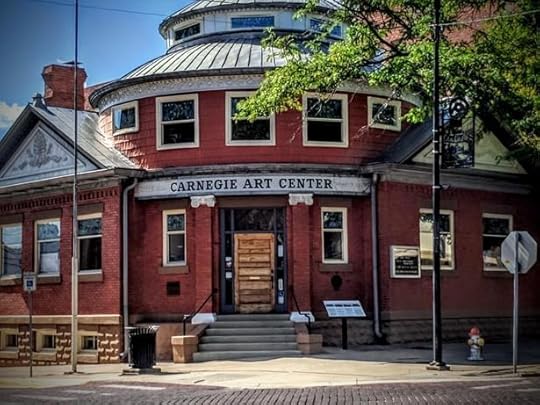
Gunfighters, buffalo hunters, drifters, railroad builders, traders, and soldiers from Fort Dodge, just up the road—that was Dodge City, Kansas, in the 1870s. Wyatt Earp, Bat Masterson, Doc Holliday, and Miss Kitty—those are some of the characters who passed through or settled there. The Atchison, Topeka and Santa Fe Railway stopped in Dodge City to move buffalo and later the Longhorn cattle from Texas. It was a famously lawless town with saloons, gambling, brothels, and shootouts. In a brief 15 years, the stuff of legends abounded, with staying power enough to draw tourists to sample it even today.
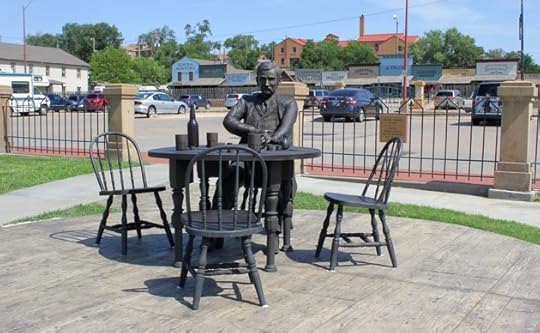
Doc Holliday, the dentist, gambler, gunfighter, and friend of Wyatt Earp (Deborah Fallows)
Fast forward two decades: electricity, water wells, sewer lines, a fire department, graded streets, and telephones arrived. Then, in 1905, another milestone: A group of distinguished Dodge City residents, including a doctor and a judge (Edward Madison, later a U.S. Congressman from Kansas), was inspired by the women’s club of Dodge City to write to Andrew Carnegie requesting support to build a library. Carnegie was already building five libraries in Kansas that year, and he granted Dodge City $7,500 for theirs. The city pledged a tenth of that sum each year to maintain the library, and they commissioned an unusual Free Eclectic Style design with a rounded front, placed diagonally, that commanded the southern corner view of commercial Second Avenue.
The library couldn’t keep up with the town, and in 1936, the town raised money, paired it with support from the WPA, and doubled the size of the library. Thirty years later, the library needed more space again, but this time, the town failed to raise the money. The library moved instead to the old Montgomery Ward building a few blocks away. In the 1970s, the building was home to two restaurants and three private clubs. In 1979, it earned a designation in the National Registry of Historic Places. The community and the Kansas State Historic Preservation Office preserved the building and today it’s home to the Carnegie Center for the Arts.
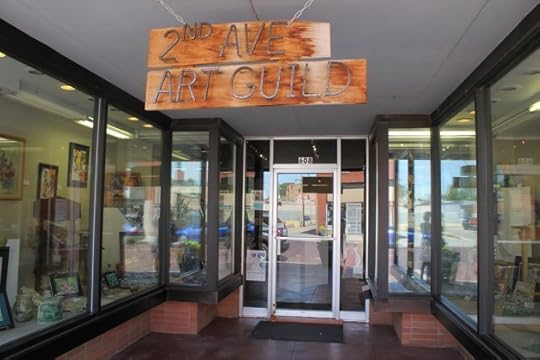
Second Avenue Art Guild in Dodge City, Kansas (Deborah Fallows)
We were lucky enough to be in Dodge City on a Final Friday evening for the monthly visual, culinary, and performing arts walk around town, which kicked off at the Carnegie Center. That Friday in June featured Wanda Adamson, a quilter from nearby Jetmore, a town of 850 people just north of Dodge City. People milled about and then drifted down to the Second Avenue Art Guild for more wine and cheese.
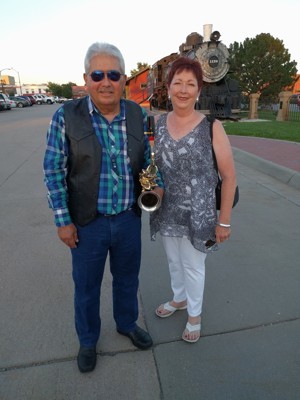
John and Connie Chavez (Deborah Fallows)
There we met John and Connie Chavez. He’s a saxophone player with the Dodge City Cowboy Band, a community band since 1879, and still performing for the town weekly during the summer. We also met a young artist, Jake Hendrix, part of a family of artists showing their work that night, who still worked on the family farm and was also launching a startup, Hendrix Keg Company, to make CO2 cartridge-powered mini-beerkegs with his brother Rob.
We ambled down to the final venue, the old Dodge City railway depot, a Richardsonian Romanesque building from the bustling rail days in 1896, and now an Amtrak stop for the Southwest Chief, which comes through town a few times a day. Mark Vierthaler, new marketing director of the startup Boot Hill Distillery, formerly of more established Servi-Tech, an agronomic services provider, was pouring his signature drink, “The Playa,” a concoction he makes from light rum, lavender syrup, and elderflower liquor.
Meanwhile, back at the Dodge City Library: Today, the Dodge City Public Library has a new home, built in 1981. Cathy Reeves is the library director. We talked about how libraries today work to get themselves out and into the communities that they serve. Reeves told me that one of her ways of doing that is to challenge the staff to have their elevator speech at the tip of their tongues when people ask, “Hi, how’s it going?” Their answer, she suggests to them, can highlight some news and activities of the library.
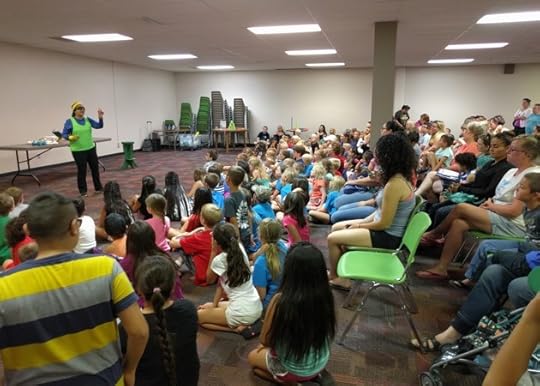
Exploration Center presenter at Dodge City public library (Deborah Fallows)
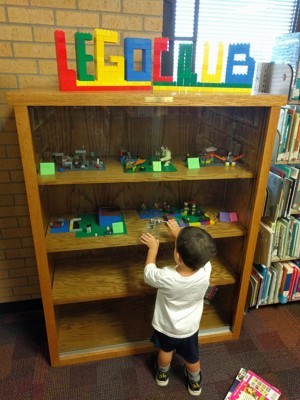
Toddler loving the Lego Center (Deborah Fallows)
The librarians have plenty to talk about. They have summer-reading programs, Lego Club for kids, lots of activities plus a Facebook site for the teens, information sessions about local issues, like the arrival of a new air service for the Dodge City airport, presentations by the Kansas Humanities Council, and first Tuesday “Coffee, Donuts, and a Movie.” The only requirement for that one is that you have to watch the movie to get the donut.
It serves the older folks, like one man I chatted with who was sitting comfortably reading the newspapers and keeping an eye on his stocks on the closed caption TV. Other adults went for the coloring books, which is a comeback fad of many generations beyond elementary schoolers today.
There are shelves of videos, CDs, and playaways, an audio player. A dedicated Spanish-language portal on the website is chock-a-block with information and resources for the Spanish speakers of Dodge City, now 60 percent of the population. Dodge City is a Family Place Library, offering all sorts of resources, workshops, and connections for parents and caregivers who are learning to raise young children.

Young people’s area at the library (Deborah Fallows)
There were scads of kids in the library each time I visited; they were searching for books, working on their summer reading programs, playing in the early childhood area, coloring and drawing. One day, I stopped in the big multi-use space in the lower level where at least 250 kids, with adults in tow, had come for a demo and program with a traveling group from the Wichita Exploration Center. A few middle schoolers were helping the kids run around obstacle courses, climb through tunnels, and try archery. I asked one of the young volunteers where she would be if not the library on that hot day. “Probably at the pool,” she said, which was indeed where I saw lots of kids, including the town’s swim team, who showed up as early as 6:30 a.m. when I swam laps there.
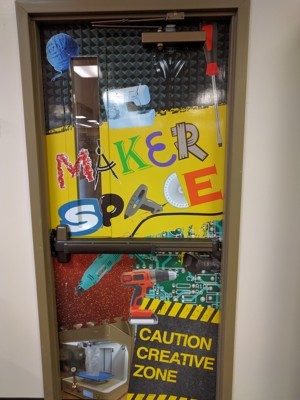
Door of the new maker space (Deborah Fallows)
The newest feature of the library is the makerspace. It was the brainchild of Chris Dressler, a young Dodge City resident who grew up shouting distance from the library and used to frequent it in his youth, before he went off to study computer science. Reeves said that Dressler badgered her for more than a year to find room for a makerspace. It finally happened and is now off to a quaintly modest start, with a donated sewing machine, hobbyist things like jewelry and leather tools, and a glue gun. The piece de resistance is a small 3-D printer, which Dressler will help anyone learn to use. The librarians said it will take a while for people to find their way to the makerspace and begin using it more. For starters, their monthly Maker Club partners with the Second Avenue Art Guild.
I think Andrew Carnegie would enjoy seeing the synergy among arts and civic life that has grown out of the library he sponsored, and he would appreciate its legacy as well as inspiration for today’s thriving Dodge City Public Library.

August 14, 2016
A Glimpse of the Chibok Schoolgirls

NEWS BRIEF The Nigerian militant group that kidnapped more than 270 schoolgirls more than two years ago has released a video purportedly showing dozens of them alive.
The footage from Boko Haram, posted on Twitter Sunday by Nigerian journalist Ahmad Salkida, appears to show more than 40 girls, covered in hijabs and some holding infants. The Islamist militant group alleges they were among the 278 abducted from their school in Chibok in northeastern Nigeria in April 2014. Dozens of girls managed to escape in the hours after the ambush, but the fate of the missing 218 girls remains unknown.
In the video, which lasts 11-and-a-half minutes, a militant, masked and dressed in camouflage, warns the Nigerian president, Muhammadu Buhari, that if bombing continues, the girls will not be seen again, according to the AP’s translation of the Hausa language. He says some of the girls have life-threatening injuries, and that 40 have been “married” to militants. Later, one of the schoolgirls addresses the Nigerian government, asking officials to release detained Boko Haram militants in exchange for the girls. She says some of the girls died in air strikes by Nigerian forces, which are trying to drive the militant group out of the country.
Here’s a still image from the video, from Reuters:
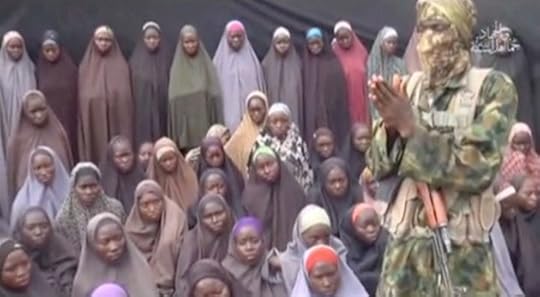
Reuters TV
The video also shows what appears to be the bodies of schoolgirls on the ground, lifeless.
The video was cited by the SITE Intelligence Group, which monitors potential jihadist activity on the internet. Nigeria’s Ministry of Information and Culture, Nigeria said in a Facebook post Sunday government officials are communicating with the individuals allegedly behind the video. Several parents have already told news organizations they recognized their daughters in the video.
In May, one of the schoolgirls was found, along with her four-month-old baby and a man claiming to be her husband, by Nigerian forces in a forest in the northeast part of the country. She was the first of the hostages to be rescued.
The insurgency of Boko Haram, which adheres to strict Sharia law and opposes Western-style education, is in its seventh year. More than 20,000 people have been killed and two million driven from their homes during the uprising. Relatives of the captive schoolgirls and other demonstrators hold regular protests in Abuja, the Nigerian capital, calling for the government to increase its efforts to find them.

The Violent Protests in Milwaukee
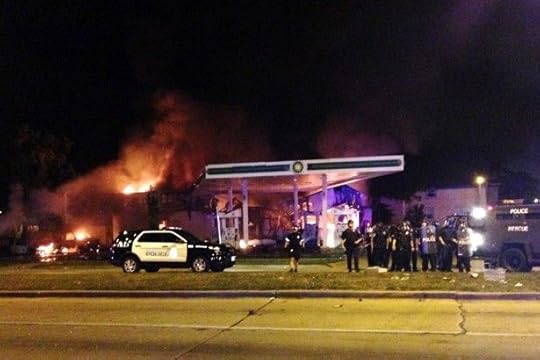
NEWS BRIEF Crowds clashed with police in Milwaukee Saturday night, setting fire to buildings, shattering bus shelters, and throwing rocks in protest against a fatal police shooting of a man in the Wisconsin city earlier that day.
The standoff lasted several hours, and at least 200 people took to the streets, police said Sunday morning local time, The New York Times reported. Three people were arrested. One officer was hospitalized after a brick was thrown through the window of his police car, injuring his head.
Video footage from the scene showed a gas station engulfed in flames:
VIDEO: Rioters chanting "black power" as gas station burns in #milwaukee pic.twitter.com/wQJ45WOocm
— Tim Pool (@Timcast) August 14, 2016
More on the scene, from the Times:
One fire, at a gas station in the Sherman Park neighborhood, burned unattended while gunshots kept firefighters from extinguishing it. Other fires burned at an auto-parts store, a beauty supply company and a bank branch.
The crowds were reacting to the death of a man Saturday afternoon, who was fatally shot by police after fleeing a traffic stop. Police said the man was armed, but the details of the incident are not yet clear. The police have not identified the race of the man or the officer who shot him.
Wisconsin Governor Scott Walker on Sunday activated the state National Guard to assist police if protests break out again.
Read Follow-Up Notes
News update and reader debate
City leaders called for peace Sunday morning. Ashanti Hamilton, an alderman on the Milwaukee Common Council, told reporters there Sunday night “we’re going to push to get information to the public. But please allow the process to work.”
Fatal police shootings, mostly of black men, have triggered similar protests in cities across the United States in the last two years.

Atlantic Monthly Contributors's Blog
- Atlantic Monthly Contributors's profile
- 1 follower



